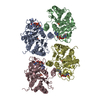+Search query
-Structure paper
| Title | Cyclic-dinucleotide-induced filamentous assembly of phospholipases governs broad CBASS immunity. |
|---|---|
| Journal, issue, pages | Cell, Vol. 188, Issue 14, Page 3744-3756.e16, Year 2025 |
| Publish date | Jul 10, 2025 |
 Authors Authors | Jingge Wang / Zhao Li / Hao Lang / Wenfeng Fu / Yina Gao / Sen Yin / Panpan Sun / Zhaolong Li / Jiafeng Huang / Songqing Liu / Yun Zhu / Fei Sun / Dong Li / Pu Gao / Ang Gao /  |
| PubMed Abstract | Cyclic-oligonucleotide-based antiphage signaling systems (CBASS), a widespread antiviral bacterial immune system homologous to the mammalian cGAS-STING pathway, synthesizes cyclic nucleotide signals ...Cyclic-oligonucleotide-based antiphage signaling systems (CBASS), a widespread antiviral bacterial immune system homologous to the mammalian cGAS-STING pathway, synthesizes cyclic nucleotide signals and triggers effector proteins to induce cell death and prevent viral propagation. Among various CBASS effectors, phospholipase effectors are the first to be discovered and are one of the most widespread families that sense cyclic dinucleotides to degrade cell membrane phospholipids. Here, we report that CBASS phospholipases assemble from a dimeric inactive state into active higher-order filamentous oligomers upon sensing cyclic dinucleotides. Using a combined approach of cryo-electron microscopy and X-ray crystallography, we have determined the structures of CBASS phospholipase in the inactive dimeric state, the cyclic-dinucleotide-bound active higher-order state, and the substrate-analog-bound catalytic mimicry state, thereby visualizing the complete conformational reorganization process. Complemented by functional assays of intermolecular binding, phospholipase enzymatic activity, in vitro membrane disruption, and in vivo antiphage efficiency, our work elucidates the mechanisms of assembly and activation of CBASS phospholipases. |
 External links External links |  Cell / Cell /  PubMed:40345202 PubMed:40345202 |
| Methods | EM (single particle) / X-ray diffraction |
| Resolution | 1.648 - 3.33 Å |
| Structure data | EMDB-60745, PDB-9ion: EMDB-60746, PDB-9iop:  PDB-9iom:  PDB-9ioq: |
| Chemicals |  ChemComp-HOH:  PDB-1aep:  ChemComp-MAY: |
| Source |
|
 Keywords Keywords | LIPID BINDING PROTEIN / CapE / patatin-like phospholipase protein |
 Movie
Movie Controller
Controller Structure viewers
Structure viewers About Yorodumi Papers
About Yorodumi Papers








